The Ultimate Guide to Small Business Wellness Programs in 2025
Last Updated Oct 23, 2025

Your small business runs thanks to your employees. They are energy, creativity, and resilience that move everything forward — and that means their wellbeing is critical to your company's performance. If they burn out, productivity tanks and costs climb, fast. Absenteeism hits harder on lean teams. Healthcare costs eat into margins. Talented employees look elsewhere for workplaces that prioritize their wellbeing. The ripple effect can stall growth before it even starts.
The good news? Wellness programs don’t need to be expensive or complicated to make a real difference. With the right mix of simple, affordable strategies, small businesses can reduce costs, boost retention, and build stronger teams—all while standing out as an employer of choice.
Ready to uncover how wellness can become one of the smartest investments your business makes? Let’s dive into low-cost, high-impact ways to put wellbeing at the center of your company’s success.
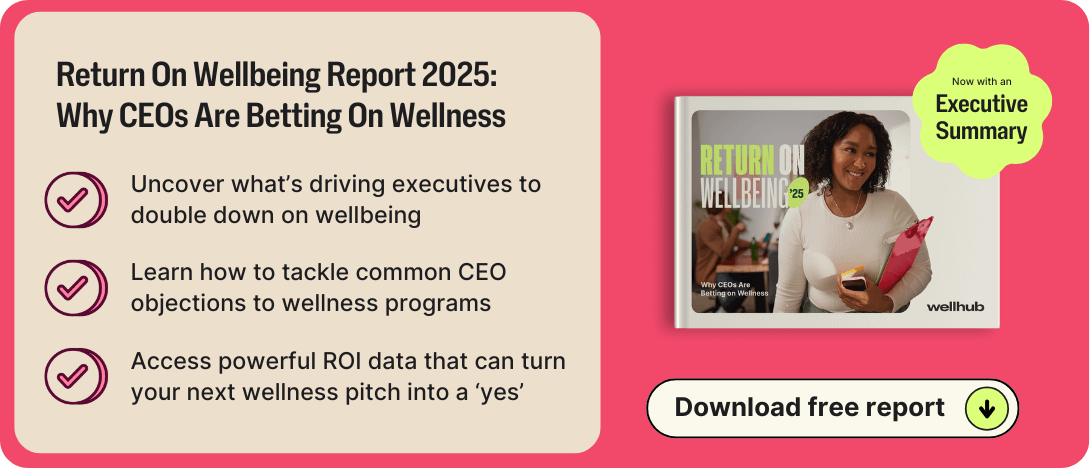
What You’ll Learn:
- The Value of Wellness for Small Businesses: Why wellness programs aren’t just for big corporations—small businesses can drive retention, productivity, and healthcare savings with simple, affordable initiatives.
- Direct & Indirect Costs Explained: A clear breakdown of what you’ll actually spend on wellness programs, from subscriptions and workshops to indirect efforts like communication, training, and employee participation time.
- Smart Budgeting Strategies: A four-step framework (define parameters, prioritize initiatives, account for all costs, plan for growth) plus a goal-oriented budgeting template that ties every dollar to measurable business outcomes.
- Proven Business Benefits: How wellness drives ROI, reduces absenteeism, lowers healthcare costs, boosts employee satisfaction, strengthens employer brand, and builds resilience—supported by recent CEO and HR data.
- Low-Cost & High-Impact Ideas: Twenty practical, budget-friendly wellness activities (like walking meetings, mindfulness breaks, and volunteer days) and best practices for boosting enrollment to maximize participation.
What are Wellness Programs for Small Businesses?
Wellness programs for small businesses—organizations with fewer than 500 employees—are initiatives designed to support the physical, mental, and emotional health of their teams.
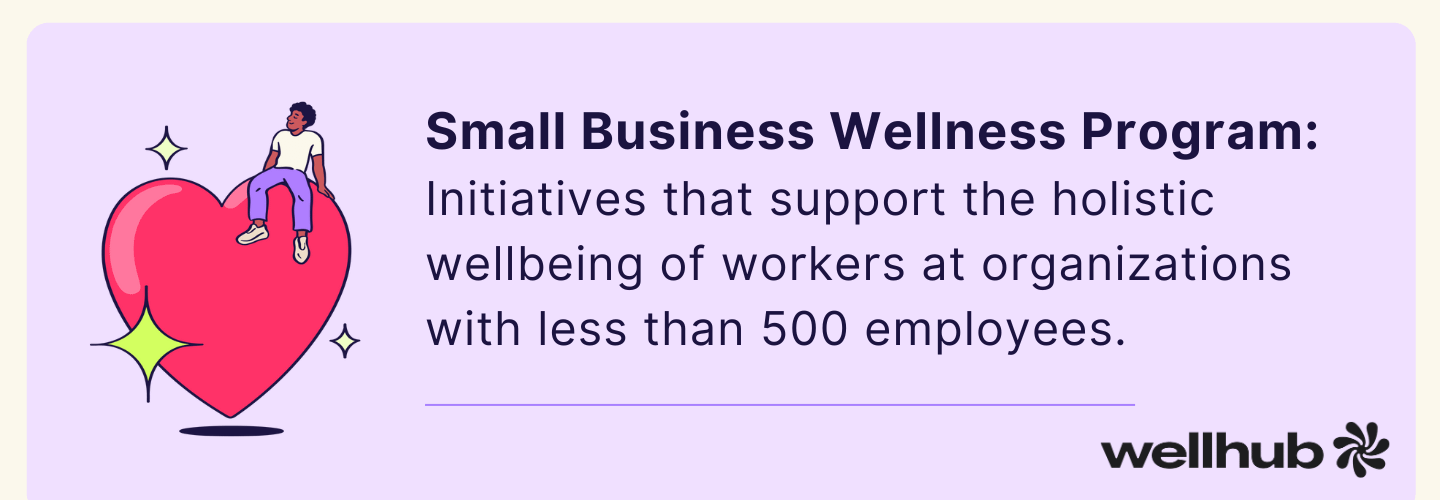
These programs are built to deliver meaningful impact without requiring a big budget or a large HR department to manage them. Think of them as intentional activities, benefits, or policies that help employees thrive both at work and at home. These programs often include things like:
- Physical health support: step challenges, healthy snack options, or sleep support apps.
- Mental wellbeing support: mindfulness breaks, stress management workshops, or access to counseling.
- Work-life wellness initiatives: flexible schedules, volunteer days, or digital detox hours.
- Financial and social wellbeing: financial literacy sessions, community service opportunities, or peer-led wellness groups.
For small businesses, the key difference is simplicity and affordability. Unlike larger organizations with full wellness budgets, small businesses often start with low-cost, high-impact ideas that can scale over time.
What it Costs to Implement Health & Wellness Programs at a Small Businesses
Wellness is one of the smartest—and most affordable—investments a small business can make. There are up-front costs (direct and indirect), but they deliver a positive return on investment.
Seventy-eight percent of CEOs say their wellness investments deliver returns greater than 50%, while nearly a third see ROI above 100%—that’s $2 back for every $1 invested. Those gains come from reduced absenteeism, lower healthcare costs, and improved employee productivity.
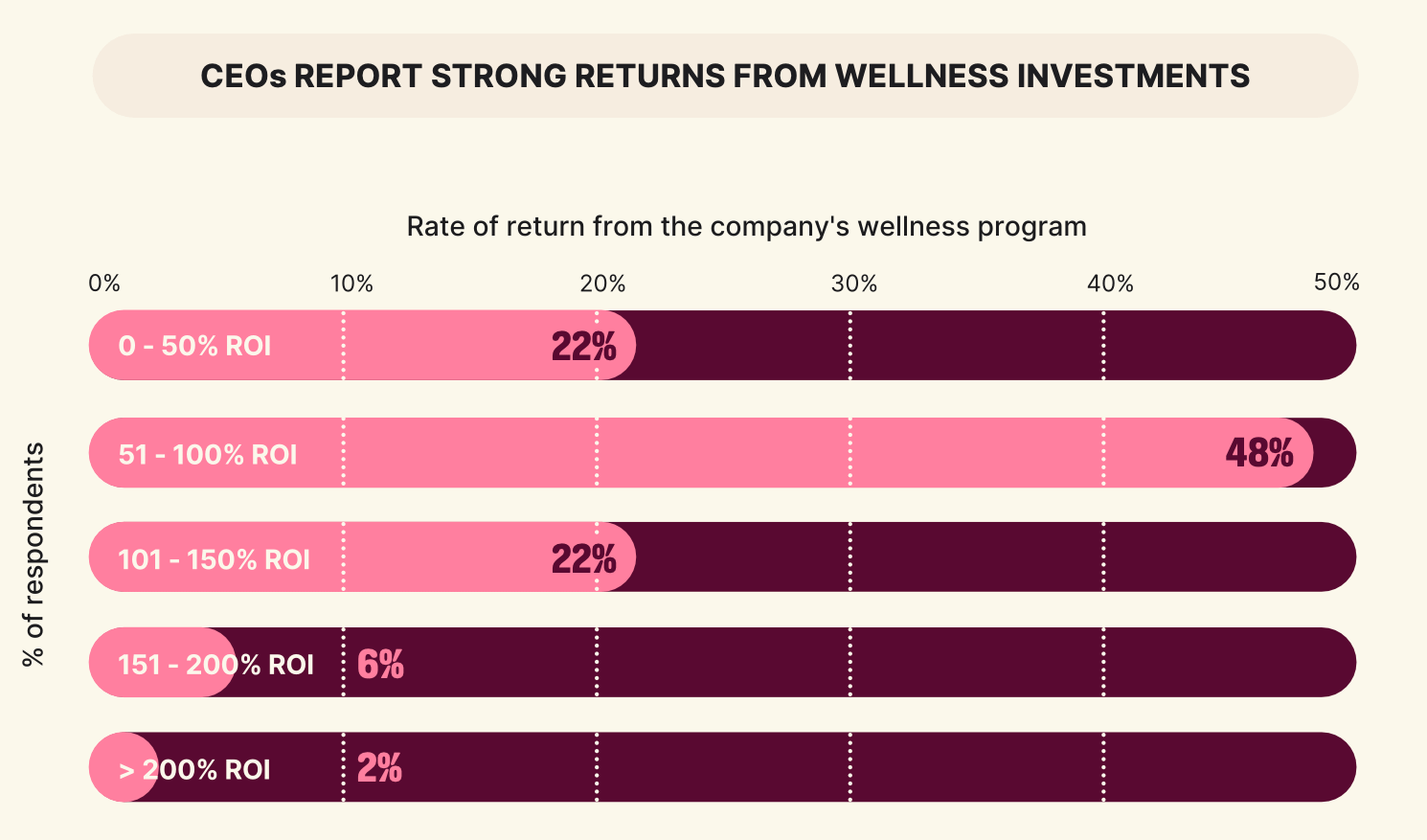
And these programs don’t require a massive investment. For example, $1,000 can give 500 employees access to Wellhub. That’s the same cost as covering just one month of GLP-1 medications for a single employee. The math is clear: wellness programs stretch your dollars dramatically further while benefiting your entire workforce.
By reframing wellness as a cost-saving, growth-driving investment instead of a luxury, small business leaders can see it for what it is: an essential part of long-term success.
Direct vs. Indirect Costs for Small Business Wellness Programs
Direct Costs
Direct costs are the expenses that show up clearly in your budget. They vary based on the scale of your program but can fit nearly any budget.
- Wellness platforms and apps: Subscriptions for platforms like Wellhub, meditation apps, or digital exercise class libraries. These provide access to thousands of resources employees can use on their own time.
- Incentives and rewards: Participation prizes, like wellness stipends, fitness trackers, or gift cards. Cost-free incentives like public recognition, extra PTO, or flexible scheduling can also spark engagement.
- On-site and virtual activities: Options like yoga classes, mindfulness workshops, or nutrition seminars can be delivered for free through community partners or at a modest cost if you bring in outside experts.
- Preventive health screenings and flu shots: Partnering with local clinics for annual screenings or hosting flu shot clinics is a practical way to reduce future healthcare claims.
- Equipment and supplies: Smaller businesses sometimes invest in items like resistance bands, hydration stations, or ergonomic tools to encourage everyday wellness at work.
Indirect Costs
Indirect costs are less tangible but play a key role in making wellness programs effective. These are more about time and effort than money.
- Administrative coordination: Even modest programs require someone to manage sign-ups, answer questions, and track engagement. Forming a cross-departmental wellness committee can spread out the workload.
- Promotion and communication: Keeping wellness top of mind means using newsletters, Slack, intranet posts, or kickoff events to drive awareness. These efforts require consistency more than dollars.
- Engagement strategies:Building a culture of wellness isn’t one-and-done. You may need to refresh offerings, rotate challenges, or survey employees for feedback to sustain interest.
- Training and education: Upskillingwellness champions, offering webinars, or providing self-guided resources helps employees make the most of the program. Free online materials and community-based programs can help keep these costs minimal.
- Opportunity cost of participation: When employees step away for a stretch break or meditation session, they’re not at their desks. But those small pauses pay off in reduced stress and better focus afterward—what you “lose” in minutes you gain back in productivity.

How Small Businesses Can Budget for Wellness Programs
Budgeting for a wellness program doesn’t have to be overwhelming. The key is to align your spending with both your company’s goals and your employees’ needs. A thoughtful budget helps you maximize ROI and ensures that wellness remains sustainable over time.
Step 1: Define Your Budget Parameters
Decide how much of your overall HR or benefits budget can be allocated to wellness. The amount doesn’t need to be large—what matters most is consistency and a clear connection to outcomes like reduced absenteeism, improved morale, or healthcare savings.
Step 2: Prioritize High-Impact Initiatives
Choose initiatives that deliver measurable benefits without requiring major investment. Walking meetings, flexible scheduling, or access to a wellness platform can all provide strong returns while keeping costs manageable.
Step 3: Account for Direct and Indirect Costs
Direct costs (like subscriptions, incentives, or workshops) are easy to track and plan for. Indirect costs (like the time managers or HR staff spend coordinating activities) are less visible but just as important. Build in space for both to get a realistic picture of your program’s true investment.
Step 4: Plan for Growth Over Time
Wellness programs don’t have to start big. Begin with simple, low-cost ideas, track engagement and outcomes, and expand as you demonstrate impact. This incremental approach makes wellness sustainable and easier to scale.
Goal-Oriented Budgeting Template for Small Business Wellness Programs
To make wellness budgeting practical, map every dollar (or percentage of your HR budget) to a specific business goal. This way, you can show leadership not just what you’re spending, but why—and what results you expect to see.
For example, consider this template:
| Business Goal | Wellness Investment Examples | Estimated Budget Allocation | Expected Impact / ROI Metric |
| Boost Retention & Engagement | Recognition programs, peer-led wellness groups, team challenges, volunteer days | $ or % of budget | Example: Reduce turnover by % within 12 months |
| Improve Productivity & Focus | Stress management workshops, mindfulness sessions, ergonomic upgrades, flex time | $ or % of budget | Example: Increase productivity by % (measured via output or engagement survey) |
| Control Healthcare Costs | Preventive screenings, flu shot clinics, nutrition workshops, activity challenges | $ or % of budget | Example: Lower healthcare claims by % or reduce absenteeism by days/employee |
| Strengthen Employer Brand | Wellness fairs, community service initiatives, flexible wellbeing stipends | $ or % of budget | Example: Improve employer brand score by points or increase candidate acceptance rates by % |
How to use this template:
- Choose 1–2 primary goals for the year (e.g., retention + healthcare cost control).
- Allocate your budget across categories that best serve those goals.
- Define success metrics up front (like retention rate, engagement scores, or reduced sick days).
- Review quarterly and adjust based on outcomes.
Advantages of Small Business Wellness Programs
- Positive Return on Investment
Wellness can improve profitability no matter your company size. As Wellhub revealed in its Return on Wellbeing 2025 report, 79% of small businesses CEOs (organizations with less than 500 employees) see a positive ROI from their wellness program.

- Improved Talent Retention
In that same survey, CEOs of smaller businesses reported they are actually more likely than medium or large business execs to see a direct tie between prioritizing wellness and improving retention.
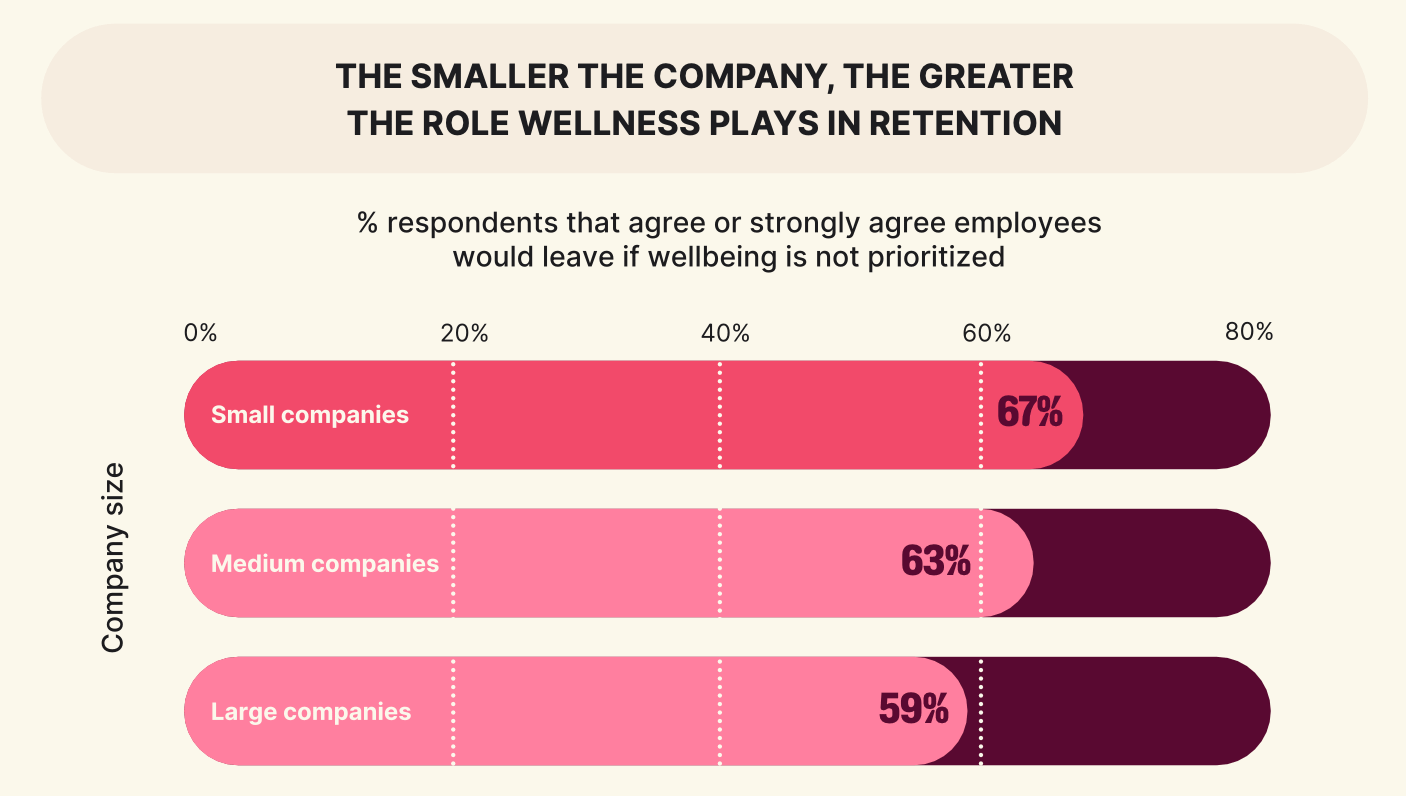
- Boosted Talent Attraction
Wellness is also a magnet for new hires. Eighty percent of CEOs say wellness initiatives strengthen their company’s ability to attract talent, and 42% describe that impact as “extremely” powerful. For small businesses competing against larger employers with bigger budgets, a strong wellness program can become a differentiator that helps level the playing field.
- Stronger Business Performance
Wellness drives more than just employee happiness—it directly fuels productivity and profitability. Nearly every CEO (97%) surveyed in Return on Wellbeing 2025 says their wellness program improves productivity, with nearly half reporting a strong impact. And the financial case is hard to ignore: Remember how 78% of CEOs report returns greater than 50% on their wellness investments, while 30% see ROI above 100%—$2 back for every $1 invested? For small businesses, where every dollar matters, this kind of return can be game-changing.
- Improved Employee Satisfaction
Wellness programs also give your people a reason to feel more connected to work. Fifty-two percent of CEOs invest in wellbeing initiatives specifically to boost morale and engagement—and employees notice: 61% of those with a wellness program say they’re happy at their company, compared to just 36% without. For small businesses, higher morale means lower turnover, more teamwork, and employees who show up ready to give their best each day.
- Reduced Absenteeism
Absenteeism costs hit small businesses especially hard because every absence is felt across a leaner team. Two-thirds (67%) of CEOs say their wellness program significantly reduces absenteeism. That means fewer sick days, more consistency for your customers, and less pressure on the employees who cover for absent teammates.
- Healthcare Cost Savings
Healthcare is one of the top budget items for small businesses, and wellness can help manage those expenses. Sixty-eight percent of CEOs say their programs directly reduce healthcare costs. That’s a major advantage when small business healthcare are expected to jump 11% in 2026. HR leaders say wellness programs deliver on this c-suite goal: 91% of HR leaders reported in 2024 that healthcare costs decreased because of their wellbeing program, up from 78% in 2023. And these drops can be significant: Healthcare costs for Wellhub users with 5 or more check-ins per month, for example, dropped by 21% a year after implementation. Meanwhile costs for non-Wellhub users rose by 14%, leading to overall savings of over 35%.
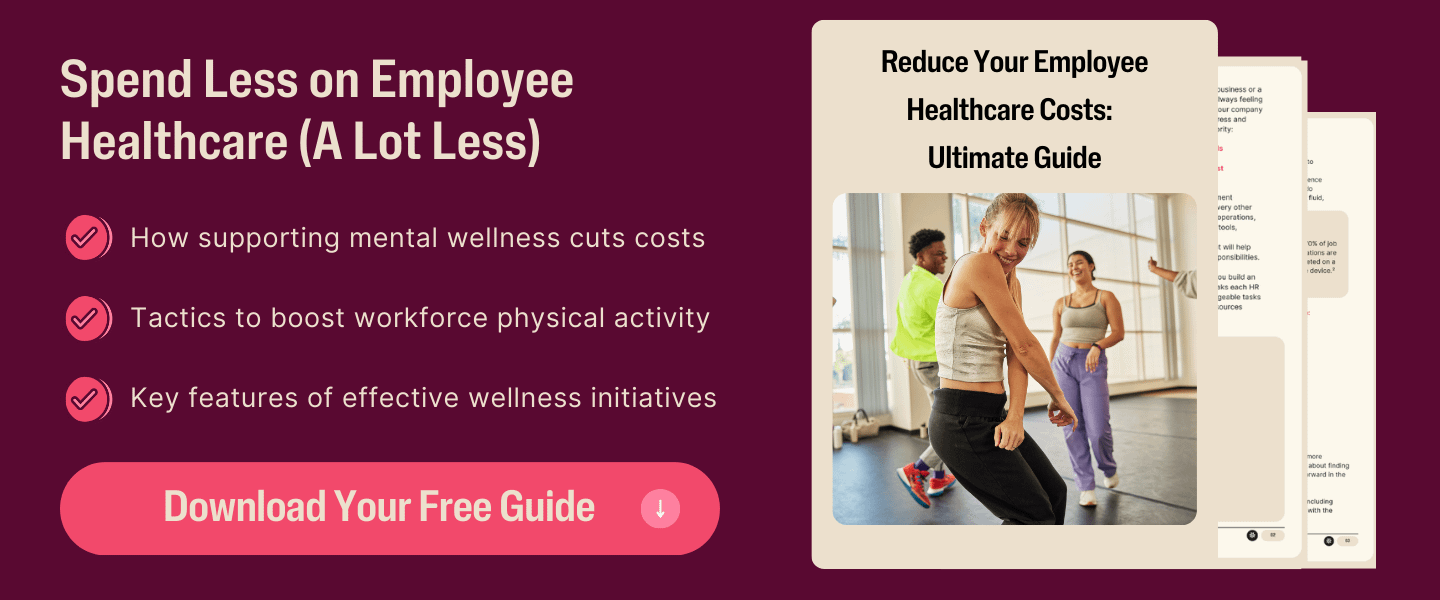
- Employee Resilience
Small businesses rely on their teams to be flexible and adaptable. The good news: 73% of CEOs say their wellness programs are very or extremely impactful in fostering resilience among employees. That means employees are better equipped to handle stress, adapt to change, and keep moving forward—even when workloads spike.
- Stronger Employer Brand
Wellness programs don’t just support employees—they also shape how your business is perceived externally. Seventy-six percent of CEOs say wellness initiatives significantly impact brand perception. For small businesses competing with larger players, a reputation as a people-first employer can make all the difference in winning customers and attracting candidates.
20 Low-Cost Wellness Program Ideas for Small Businesses
Wellness doesn’t have to break the bank. In fact, many of the most impactful initiatives are free—or close to it. For small businesses working with lean budgets, low-cost wellness programs can build a culture of care, boost engagement, and even reduce turnover.
Here are 20 ideas you can roll out quickly and affordably:
- Walking meetings – Swap the conference room for a stroll outside. Movement sparks creativity and lowers stress.
- Flexible work hours – Give employees room to balance their personal wellness needs with work.
- Mindfulness breaks – Use free meditation apps or host a short guided session during the week.
- Healthy snack swaps – Replace vending machine candy with fruit bowls or bulk-purchased trail mix.
- Hydration challenges – Encourage water intake with a friendly team competition.

- Peer-led wellness groups – Tap into employee talents, like yoga or strength training, for in-house sessions.
- Wellness newsletters – Share free tips on nutrition, sleep, and exercise from credible sources.
- Walking or step challenges – Use free apps or spreadsheets to track steps and celebrate progress.
- Financial literacy workshops – Partner with local banks or nonprofits to offer no-cost training.
- Gratitude practices – Encourage teams to share weekly wins or thank-you notes.
- Stretch breaks – Schedule optional five-minute desk stretches during long meetings.
- Remote coworking hours –Create a virtual “wellness room” for connection and accountability.
- Healthy potlucks – Organize themed lunches where employees share nutritious dishes.
- Volunteer days – Allow time off for community service, a proven boost for morale and purpose—this is an affordable win when 35% of workers say their company rarely or never gives employees time for charitable activities.
- Desk ergonomics tips – Share DIY hacks for posture, stretching, and comfort.
- Sleep hygiene education – Offer resources on rest—critical since 71% of workers get less than seven hours of sleep a night.
- Gamify wellbeing – Use free leaderboards to track health habits like hydration or mindfulness minutes.
- Low-cost fitness perks – Negotiate discounts with local gyms or explore all-in-one wellbeing platforms.
- Buddy systems – Pair employees to check in on wellness goals, functioning as personal wellness champions.
- Digital detox hours – Encourage screen-free time blocks during the day.
By starting simple, you can build momentum toward a stronger culture of wellbeing—and show employees you care about their health as much as their contributions.
How to Roll Out a Wellness Program for Your Small Business
Launching Wellhub as an employee benefit is refreshingly simple. The process is designed to be seamless from start to finish whether you’ve got 20 teammates in one office or thousands spread around the globe
Step 1: Request a Quote
Head to the Wellhub for Companies site and request a free quote with your work email. That’s the spark that sets everything in motion.
Step 2: Consultation & Setup
A Wellhub representative will connect with you to understand your company’s unique needs, your team size, and the plan options that fit. You’ll get hands-on support during setup so nothing falls through the cracks.
Step 3: Launch the Program
Your wellness program can be live in less than 30 days. We’ll equip you with communication materials to make rollout smooth and engaging for employees from day one.

Step 4: Employee Onboarding
Once active, employees download the Wellhub app, create their accounts, and choose the plan that best supports their goals. Each teammate gets the flexibility to start where they are and grow from there.
Step 5: Easy Administration
As the program admin, you’ll have access to the Wellhub dashboard. From there, you can manage eligibility, track engagement, and measure ROI — often with as little as 15 minutes of admin work a month.
Who Pays for Wellhub?
Wellhub uses a co-payment model. Both your company and your employees share the investment, which makes wellness benefits accessible and sustainable.
- For Your Company: Costs are based on an annual contract with monthly payments, tailored to team size and investment level. That means you’ll receive a personalized quote designed specifically for your business.
- For Employees: Teammates can choose the plan that works for their needs and budget. Options range from a free digital plan with access to top wellness apps to paid plans that unlock in-person gyms, studios, classes, and premium digital content. Paid plans in the U.S. start at just $11.99 per month. Employees can pause, cancel, or switch plans at any time, keeping their wellness experience flexible.
7 Best Practices for Employee Enrollment in a Wellness Program
Launching a wellness program is just the first step. Its success depends on how many employees actually take part. For small businesses, where every person counts, enrollment is critical. Here are best practices to make sign-ups seamless, engaging, and effective.
- Make Enrollment Simple and Accessible
Keep the sign-up process quick and intuitive. Use a central platform or an easy online form rather than paper-based systems. Make sure employees know exactly where to go, whether that’s a company portal, an app, or a single shared link.
- Communicate Early and Often
Awareness drives participation. Introduce your program with a kickoff meeting or a launch event, then reinforce it with reminders in team huddles, newsletters, Slack, or even posters in common spaces.
- Lead with Benefits, Not Features
Focus on outcomes that matter to employees. Instead of saying “We’re offering yoga classes,” say “This free program can help you reduce stress, improve sleep, and have more energy for your family.” Employees who believe wellness is affordable and accessible report much higher wellbeing than those who don’t.
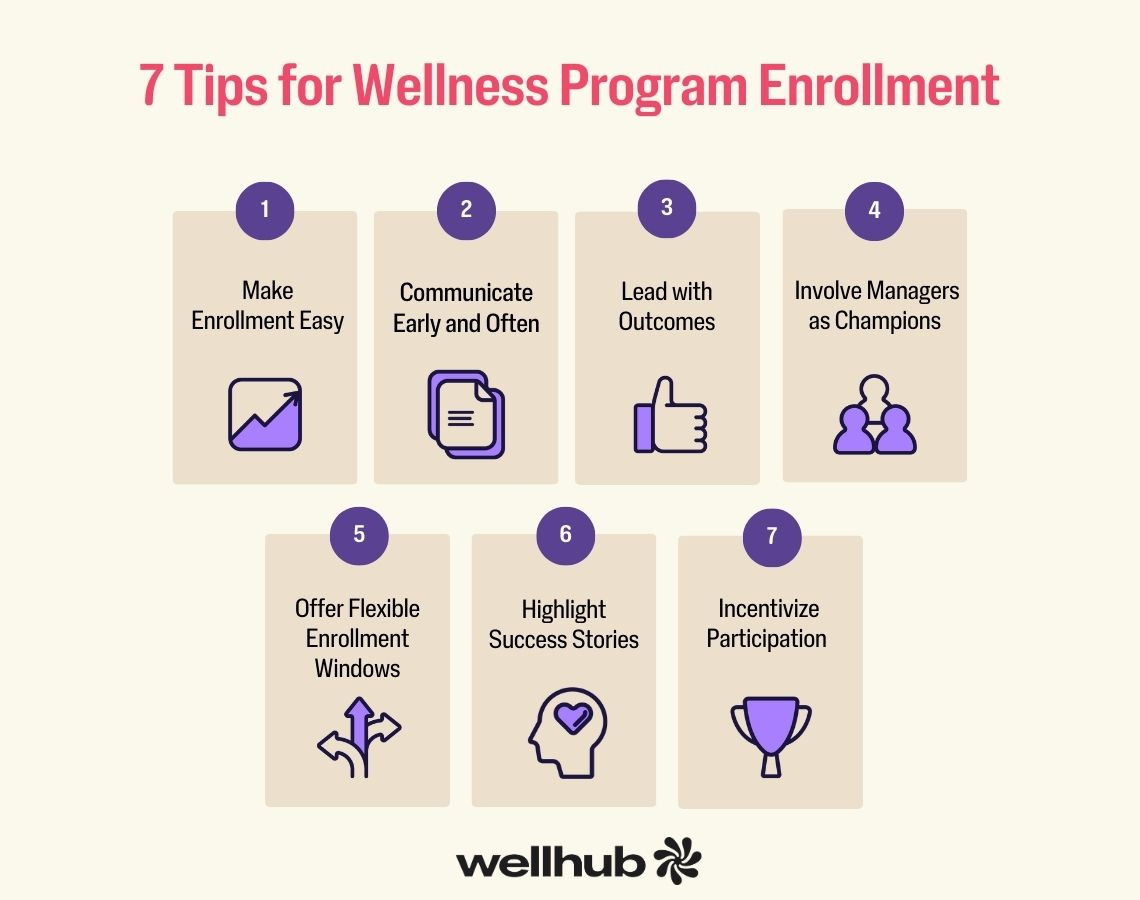
- Involve Managers as Champions
Managers are the bridge between HR and employees. Encourage them to talk about wellness in one-on-ones and team meetings. When leaders participate openly—like joining a walking challenge or attending a mindfulness session—employees follow suit.
- Offer Flexible Enrollment Windows
Not every employee can sign up right away. Provide multiple enrollment periods or rolling enrollment so employees can join when it makes sense for them. This is especially important for small businesses with varied schedules or seasonal work.

- Highlight Success Stories
Share testimonials from employees who have benefited. A colleague saying “I finally got better sleep thanks to this program” can be more powerful than any HR memo. Stories humanize the program and show its real-world impact.
- Incentivize Participation
While some employees are naturally motivated, others may need a nudge. Small incentives like wellness stipends, recognition in team meetings, or bonus PTO hours can drive sign-ups without breaking the budget.
Wellness Makes Sense—and Money—for Small Businesses
Small businesses face a tricky balancing act: offering meaningful employee benefits without stretching limited budgets or resources. Wellness programs often feel out of reach, but skipping them means missing out on lower healthcare costs, reduced absenteeism, and stronger employee engagement.
An employee wellbeing program like Wellhub removes the guesswork and heavy lifting. It brings affordable, scalable wellness to businesses of all sizes—without adding administrative burden.
Speak with a Wellhub Wellbeing Specialist to launch a cost-effective wellness program that drives your small business forward.

Company healthcare costs drop by up to 35% with Wellhub*
See how we can help you reduce your healthcare spending.
Category
Share

The Wellhub Editorial Team empowers HR leaders to support worker wellbeing. Our original research, trend analyses, and helpful how-tos provide the tools they need to improve workforce wellness in today's fast-shifting professional landscape.
Subscribe
Our weekly newsletter is your source of education and inspiration to help you create a corporate wellness program that actually matters.
Subscribe
Our weekly newsletter is your source of education and inspiration to help you create a corporate wellness program that actually matters.
You May Also Like

Corporate Wellness Trends HR Must Know for 2026 | Wellhub
See the top 2026 wellness trends shaping performance, retention, and culture—plus how HR can build a unified, ROI-driven wellbeing strategy.

Wellness Points Programs: Boost Employee Health & Engagement | Wellhub
Turn your workplace wellness strategy around with a points program that rewards healthy behavior with perks, from extra time off to gift cards.

Employee Financial Wellness Programs: Ultimate HR Guide | Wellhub
Create an effective financial wellness program that supports your employees in their financial needs, boosting productivity and retention.